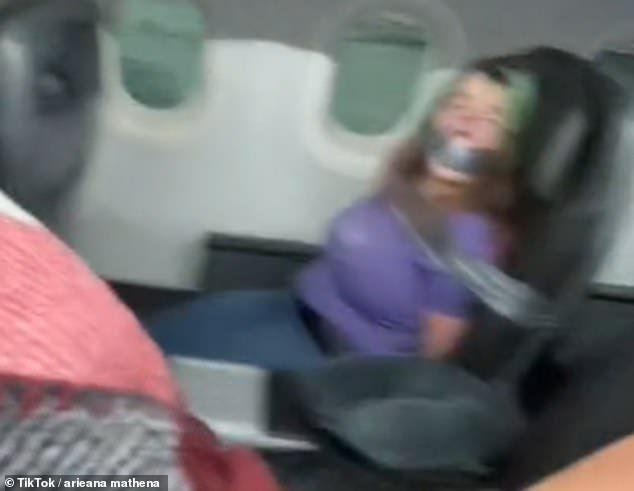Controversial Use of Duct Tape to Restrain Passenger on Las Vegas Flight Sparks Legal and Public Backlash
A recent flight departing from Las Vegas descended into turmoil when a female passenger was physically restrained by the cabin crew using duct tape after allegedly exhibiting disruptive behavior mid-flight. This drastic action, taken approximately 45 minutes after takeoff on a route to Dallas, ignited immediate outrage among fellow travelers and observers alike. Eyewitnesses recounted a tense and chaotic atmosphere as crew members prioritized safety but resorted to an unconventional and extreme method of restraint. Upon landing,law enforcement intervened,and a judge has since mandated the passenger’s detention pending further legal review.
Incident Overview and Key Facts
- Initial attempts by crew to verbally calm the passenger were unsuccessful.
- The passenger reportedly showed signs of distress and refused to comply with crew instructions.
- Duct tape was applied around the passenger’s arms and torso to prevent further disruption.
- Authorities detained the individual upon arrival for evaluation and potential charges.
- The airline is facing significant criticism for employing such an improvised restraint technique.
| Flight Details | Data |
|---|---|
| Route | Las Vegas to Dallas |
| Time of Incident | Approximately 45 minutes after takeoff |
| Method of Restraint | Duct tape applied to arms and torso |
| Passenger Status | Held in custody by court order |
Legal Actions and Safety Protocol Scrutiny
In response to the incident, legal authorities have promptly ordered the detention of the involved flight crew members as investigations proceed. This move reflects growing concerns about whether the crew’s actions adhered to established safety guidelines and respected passenger rights. Aviation law experts highlight that the use of such forceful restraint methods demands rigorous justification and must align with federal aviation standards and human rights considerations.
Investigators are currently examining several critical aspects, including:
- Adherence to federal aviation safety regulations during the incident.
- The adequacy of crew training and decision-making processes in handling in-flight disturbances.
- Protection of passenger rights and ethical treatment during conflict resolution.
| Legal Focus | Current Status | Potential Impact |
|---|---|---|
| Detention of Crew | Enforced immediately | Suspension from flight duties pending outcome |
| Review of Safety Procedures | Ongoing investigation | May lead to revised in-flight conflict management policies |
| Passenger Rights Examination | Under legal review | Could influence national aviation regulations |
Insights from Industry Experts on Passenger Rights and Airline Responsibilities
The episode involving the use of duct tape to restrain a passenger has sparked intense debate among legal and aviation professionals regarding the boundaries of airline authority and passenger protections. Experts stress that while flight attendants are responsible for maintaining order and safety, any physical restraint must be proportionate, legally justified, and executed using approved methods rather than improvised materials.
Key recommendations from specialists include:
- Obvious Interaction: Airlines should clearly inform passengers about behavioral expectations and consequences for violations.
- Use of Approved Restraints: Physical containment should rely on standardized equipment such as handcuffs or approved restraints, avoiding makeshift solutions like duct tape.
- Thorough Documentation: All incidents involving restraint must be thoroughly recorded to ensure accountability and protect legal rights.
- Access to Legal Remedies: Passengers must have avenues to contest any excessive or unlawful use of force through judicial processes.
| Aspect | Recommended Practice | Legal Consideration |
|---|---|---|
| Restraint Techniques | Employ certified restraints; avoid improvised materials | Compliance with FAA and civil rights laws |
| Passenger Notification | Inform passengers of reasons and rights during restraint | Prevents claims of unlawful detention or mistreatment |
| Post-Incident Protocol | Immediate reporting to authorities and airline management | Ensures proper legal and procedural follow-up |
Strategies for Airlines to Improve Crew Training and Conflict Resolution
In light of this and similar incidents,it is imperative that airlines bolster their training programs to better equip flight attendants with effective conflict de-escalation skills. The unique pressures of in-flight environments require crew members to respond swiftly yet sensitively to disruptive behavior, minimizing the need for physical intervention. Modern training should incorporate role-playing scenarios, psychological preparedness, and stress management techniques to enhance crew readiness.
Essential Training Enhancements Include:
- Advanced Communication Skills: Emphasizing empathy and active listening to defuse tensions.
- Non-Physical Intervention Methods: Prioritizing verbal and psychological tactics over physical restraint.
- Ongoing Education: Regular refresher courses to keep crews updated on best practices and regulatory changes.
- Stress Resilience Training: Preparing staff to maintain calm and make sound decisions under pressure.
| Training Focus | Core Elements | Benefits |
|---|---|---|
| Communication | Active listening, empathy | Reduces misunderstandings and escalations |
| Conflict De-escalation | Verbal calming techniques, psychological strategies | Minimizes need for physical restraint |
| Stress Management | Mindfulness, resilience training | Enhances decision-making under pressure |
| Legal and Ethical Awareness | Passenger rights, regulatory compliance | Reduces liability and protects passenger dignity |
Final Thoughts: Balancing Safety and Passenger Rights in Aviation
The unsettling episode on the Las Vegas flight, where a passenger was restrained with duct tape by airline staff, has ignited a critical conversation about the boundaries of in-flight safety measures and the protection of individual freedoms. As legal proceedings unfold and investigations continue, the aviation industry faces mounting pressure to refine protocols that safeguard both crew and passengers without compromising human rights. This incident underscores the urgent need for airlines to adopt comprehensive training, clear policies, and transparent communication to navigate the complex challenges of managing disruptive behavior in the skies.










